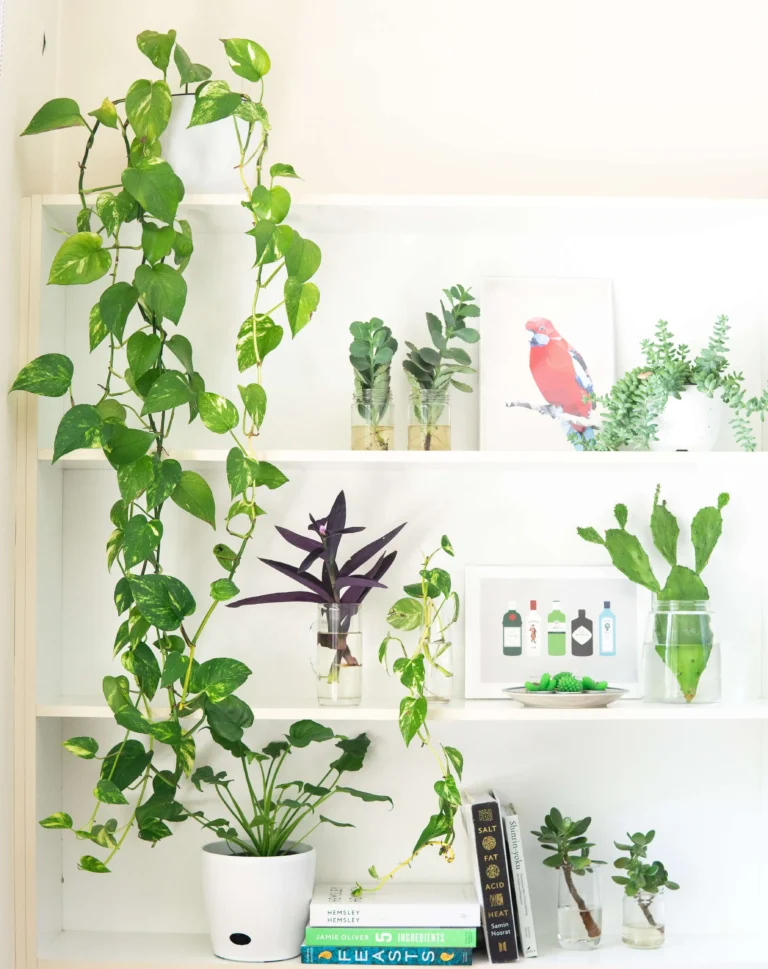Indoor Bamboo Palms Care: How to Plant & Grow

Bamboo palms, scientifically known as Chamaedorea, are an attractive and diverse group of palm species that have found their way into homes, offices and interior landscapes around the world, known for its beautiful fronds and air-purifying properties, this plant variety has become a symbol of serenity and tropical beauty within indoor spaces.
Originating in the lush forests of Central and South America, the bamboo palm has adapted admirably to life indoors, making it a favorite choice for both experienced plant enthusiasts and beginners. . Its unique characteristics, including beautiful stems, different sizes, and adaptation to different lighting conditions, have earned it a special place among indoor plants.
We’ll explore the fascinating world of bamboo palms, looking at their different species, care requirements, and the benefits they bring to our indoor environment. Whether you’re looking to add a touch of the tropics to your home or improve the air quality inside your workplace, the bamboo palm stands out as a green, soothing and evergreen companion. Who is ready to thrive by your side.
Bamboo Palm Varieties
Chamaedorea Seifrizii (Reed Palm)
Chamaedorea Seifrizii, often called red palm, is a popular indoor palm known for its beautiful appearance and flexibility. This palm species originates from Mexico and Central America and has become a favorite choice for indoor plant enthusiasts worldwide.
Characteristics:
- Fronds: The Reed Palm boasts gracefully arching fronds that resemble bamboo leaves, lending a tropical and airy ambiance to any space.
- Size: It typically reaches a height of 6 to 8 feet when grown indoors, making it a perfect choice for homes or offices with limited space.
- Light Requirements: Reed Palms thrive in bright, indirect light. They can tolerate lower light conditions, but their growth may slow down in such settings.
- Watering: Keep the soil consistently moist but not waterlogged. Allow the top inch of soil to dry out between waterings.
- Temperature: Maintain a temperature range of 70°F to 80°F (21°C to 27°C) for optimal growth.
- Humidity: While not overly demanding, Reed Palms benefit from occasional misting to create a slightly more humid environment.
Chamaedorea Elegans (Parlor Palm)
Chamaedorea Elegans, often known as the parlor palm, is an attractive and adaptable indoor palm that has been a favorite among plant enthusiasts for centuries. This palm species is native to the rainforests of southern Mexico and Guatemala, where it thrives in the dappled shade of the forest floor.
Characteristics:
- Fronds: The Parlor Palm features delicate, feather-like fronds that give it a graceful and lacy appearance. Its lush green foliage is visually appealing and complements various interior styles.
- Size: Parlor Palms are relatively compact, typically reaching heights of 2 to 4 feet indoors. This makes them an ideal choice for smaller spaces or as tabletop decor.
- Light Requirements: One of the Parlor Palm’s remarkable qualities is its adaptability to low-light conditions. While it prefers bright, indirect light, it can thrive in areas with minimal natural light.
- Watering: Keep the soil evenly moist but avoid overwatering, as the plant is sensitive to standing water.
- Temperature: Parlor Palms thrive in temperatures between 65°F to 75°F (18°C to 24°C) and are generally not tolerant of cold drafts.
- Humidity: While they can tolerate lower humidity levels, they appreciate occasional misting or placement on a humidity tray.
Chamaedorea Costaricana (Bamboo Palm or Costa Rica Bamboo Palm)

Chamaedorea Costaricana, often called the Bamboo Palm or Costa Rica Bamboo Palm, is an attractive indoor palm species native to the lush rainforests of Costa Rica and Central America. Known for its tall, slender trunks and abundant fronds, this palm adds a tropical touch to any interior setting.
Characteristics:
- Stems: The most distinctive feature of the Costa Rica bamboo palm is its tall, bamboo-like stems. These sturdy stems can reach impressive heights, making it a striking and eye-catching indoor plant.
- Fronds: Palm fronds are pinnate, meaning they resemble the shape of feathers, giving it a lush, tropical look.
- Size: When grown indoors, the bamboo palm typically reaches a height of 6 to 10 feet, making it an excellent choice for larger spaces.
Light Requirements: Although it prefers bright, indirect light, this palm can tolerate moderate to low light conditions, although growth may be slow in such settings. - Watering: Keep the soil constantly moist but not soggy. Allow the top inch of soil to dry out between watering sessions.
Temperature: Maintain a temperature range of 70°F to 80°F (21°C to 27°C) for optimal growth. - Humidity: Although not overly demanding, bamboo palms benefit from occasional misting to maintain a slightly more humid environment.
How To Grow Bamboo palms

Planting and growing bamboo palms indoors is a great way to bring greenery and fresh air into your home. First, find a spot with indirect sunlight, such as near a north- or east-facing window, as these plants like bright light. Next, choose a pot with good drainage, so that the roots are not waterlogged. Use well-draining soil, peat moss, perlite, and regular potting soil work well. When planting, make sure the palm is sitting at the same depth as in its previous pot, water it well, and allow the top inch of soil to dry out between waterings. Keep your indoor space between 70°F and 80°F and mist the palm occasionally for moisture. Feed it with a balanced fertilizer during the growing season, cut off yellow leaves, avoid pests, and your bamboo palm will thrive, adding beauty and clean air to your home.
Bamboo Palms Care Tips

Bamboo palms, are known for their lush foliage and air-purifying properties. Follow these care tips to ensure your bamboo palm thrives and remains a healthy and vibrant addition to your indoor space:
- Lighting Requirements:
Bamboo palms prefer bright, indirect sunlight. Place them near a north- or east-facing window where they can receive filtered sunlight. Although they can tolerate low light conditions, their growth can be slow in such settings.
- Watering:
Keep the soil consistently moist but not waterlogged. Water well and allow the top inch of soil to dry out between watering sessions. Make sure your pot has good drainage to prevent root rot.
- Humidity:
Bamboo palms appreciate moderate humidity levels. Occasionally misting the flags or using a humidity tray can help create a more suitable environment, especially in dry indoor spaces.
- Temperature:
Maintain a temperature range of 70°F to 80°F (21°C to 27°C) for optimal growth. Avoid exposing the plant to cold drafts or extreme temperature fluctuations.

- Fertilization:
Feed your bamboo palm with a balanced liquid fertilizer every two months during the growing season (spring and summer). Reduce feeding to once every four months during the dormant season.
- Pruning:
Trim any yellow or brown stems regularly to encourage healthy growth and maintain the plant’s appearance. Use clean and sharp scissors or pruning shears for this task.
- Pest Control:
Keep an eye out for common pests like spider mites and mealybugs. If you notice an infestation, treat the plant with neem oil or insecticidal soap to kill the pests.
- Reporting:
Repot your bamboo palm every 2-3 years or when it is rooted. Choose a slightly larger pot with good drainage, and freshen the soil mix.
- Soil Mixture:
Use a well-draining potting mix that retains some moisture. A regular potting soil mix of peat moss, perlite, and bamboo palms is usually suitable.
Bamboo Palm Benefits
Bamboo palm, scientifically known as Chamaedorea, offers many benefits beyond its aesthetic appeal when used as a decoration. This beautiful and vibrant plant not only adds a touch of the tropics to your interior space, but also contributes to your overall health. Its lush, feathery fronds not only create a calming environment but also act as a natural air purifier, effectively removing pollutants from the air and increasing oxygen levels. Additionally, bamboo palms are an excellent choice for increasing humidity in dry indoor environments, making it especially beneficial during the winter months. Its adaptability to a variety of light conditions, low maintenance requirements and beautiful appearance make it an excellent choice for both experienced and novice plant enthusiasts. Whether placed in a living room, office, or bedroom, the bamboo palm not only elevates the visual appeal of the space but also creates a healthier and more peaceful environment, which truly combines beauty and function in interior decoration.
Frequently Asked Questions (FAQs)
How often should I water my indoor bamboo palm?
Water your bamboo palm when the top inch of soil feels dry. This usually translates to watering every 1-2 weeks.
Can I keep my bamboo palm in a low light environment?
While bamboo palms prefer bright, indirect light, they can tolerate low light conditions. Just be prepared for slow progress.
Are bamboo mats safe for pets?
Yes, bamboo mats are non-toxic to cats and dogs, making them a safe choice for pet owners.
Do bamboo palms need regular pruning?
Yes, regular pruning is necessary to remove dead or yellowing stems and to maintain the health and appearance of the plant.
How can I increase humidity around my bamboo palm?
You can increase the humidity by misting the plant’s leaves, placing a tray of water, or using a humidifier in the room.


